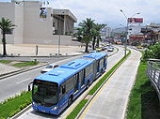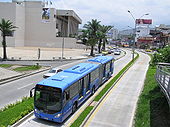
Masivo Integrado de Occidente
Encyclopedia
The Masivo Integrado de Occidente (Western Mass Integrated), also referred to as MIO, is a bus rapid transit
system that serves Santiago de Cali
, Colombia
. The system is operated through articulated bus
es which move in dedicated lanes. Approximately the 97% of the spatial perimeter of the city will be involved by this system, involving nearly 243 kilometers. The MIO will cover approximately 72% of Cali's public transportation needs.
This project will be set in motion by an investment of US$405 million; of which, 70% will be contributed by the Colombian government and the remaining 30% by the municipality of Cali. These resources are destined to finance MIO's infrastructure: construction of trunks, fueling stations, rest stops, the system of stations, pedestrian bridges, terminals, and yards. The buses will have a capacity of 160 passengers and will circulate exclusively on the trucks; in turn, the register type buses will transport between 80 and 100 people and they will travel through tramways and special diversions.

Trunk Routes:
The routes with an E are express and do not stop at all the stations:
The Routes with a T are trunks and stop at all the stations:
The Trunk roads:
Transferring terminals
Bus rapid transit
Bus rapid transit is a term applied to a variety of public transportation systems using buses to provide faster, more efficient service than an ordinary bus line. Often this is achieved by making improvements to existing infrastructure, vehicles and scheduling...
system that serves Santiago de Cali
Santiago de Cali
Santiago de Cali , simply referred to as Cali, is a city in western Colombia and the capital of the Valle del Cauca Department. With a population of 2.5 million, Cali is the third largest city in the country. It has one of the fastest growing economies and infrastructure in the country because...
, Colombia
Colombia
Colombia, officially the Republic of Colombia , is a unitary constitutional republic comprising thirty-two departments. The country is located in northwestern South America, bordered to the east by Venezuela and Brazil; to the south by Ecuador and Peru; to the north by the Caribbean Sea; to the...
. The system is operated through articulated bus
Articulated bus
An articulated bus is an articulated vehicle used in public transportation. It is usually a single-deck design, and comprises two rigid sections linked by a pivoting joint...
es which move in dedicated lanes. Approximately the 97% of the spatial perimeter of the city will be involved by this system, involving nearly 243 kilometers. The MIO will cover approximately 72% of Cali's public transportation needs.
This project will be set in motion by an investment of US$405 million; of which, 70% will be contributed by the Colombian government and the remaining 30% by the municipality of Cali. These resources are destined to finance MIO's infrastructure: construction of trunks, fueling stations, rest stops, the system of stations, pedestrian bridges, terminals, and yards. The buses will have a capacity of 160 passengers and will circulate exclusively on the trucks; in turn, the register type buses will transport between 80 and 100 people and they will travel through tramways and special diversions.
Fares

- The standard fare is of $1.500 Pesos, about US$0.75.
Routes and stations
MIO has the following routes:Trunk Routes:
The routes with an E are express and do not stop at all the stations:
- E21: Starts at Las Américas Station; stops at Versalles, Torre de Cali, Petecuy, San Pascual, Estadio, Tequendama, Unidad Deportiva, Pampalinda, Refugio, Caldas, Capri, Buitrera Stations, and ends at Universidades Station.
- E27: Starts at Las Américas Station, stops at all the stations of the Avenida 3ra Norte until Torre de Cali Station, and then, only stops at Santa Rosa, Santa Librada, Manzana del Saber, Estadio, Lido Stations, and ends at Unidad Deportiva Intermediate Terminal.
- E31: Starts at Chiminangos Station; stops at Flora Industrial, Torre de Cali, San Bosco (Towards south), San Pascual (Towards north), Estadio, Tequendama, Unidad Deportiva, Pampalinda, Buitrera Stations and ends at Universidades Station. (This route only works on 5:30 to 9:30 and 4:00 to 8:00, Mondays to Saturdays).
- E37: Starts at Chiminangos Station; stops at Flora Industrial, Torre de Cali, Centro (Towards south), San Pedro (Towards North), Petecuy (Towards North), Estadio, Tequendama Stations and ends at Unidad Deportiva Intermediate Terminal.
The Routes with a T are trunks and stop at all the stations:
- T31: Starts at Chiminangos Station, and ends at Universidades Station.
- T40: Starts at Andrés Sanín Terminal and ends at Plaza de Caycedo Station.
- T47A: Starts at Andrés Sanín Terminal and ends at Capri Station.
- T47B: Starts at Andrés Sanín Terminal and ends at Unidad Deportiva Station.
The Trunk roads:
- Avenida Las Américas
- Avenida 3rd North
- Calle 5ta - Carrera 100
- Carrera 15
- Calle 15 (one way)
- Calle 13 (one way)
- Carrera 1ra
Transferring terminals
- Terminal Universidades
- Terminal Unidad Deportiva
- Terminal Andrés Sanín
- Terminal Chiminangos

